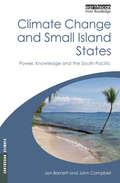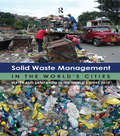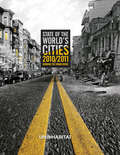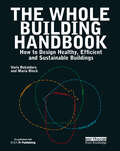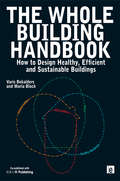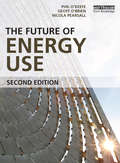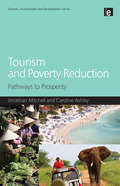- Table View
- List View
Energy and the New Reality 1: Energy Efficiency and the Demand for Energy Services
by Danny HarveyReducing and managing humanity's demand for energy is a fundamental part of the effort to mitigate climate change. In this, the most comprehensive textbook ever written on the subject, L.D. Danny Harvey lays out the theory and practice of how things must change if we are to meet our energy needs sustainably. The book begins with a succinct summary of the scientific basis for concern over global warming, then outlines energy basics and current patterns and trends in energy use. This is followed by a discussion of current and advanced technologies for the generation of electricity from fossil fuels. The book then considers in detail how energy is used, and how this use can be dramatically reduced, in the following end-use sectors: - buildings - transportation - industry - food and agriculture - municipal services The findings from these sector-by-sector assessments are then applied to generate scenarios of how global energy demand could evolve over the coming decades with full implementation of the identified and economically-feasible energy-saving potential. The book ends with a brief discussion of policies that can be used to reduce energy demand, but also addresses the limits of technologically-based improvements in efficiency in moderating demand and of the need to re-think some of our underlying assumptions concern ends with a brief discusing what we really need. Along with its companion volume on C-free energy supply, and accompanied by extensive supplementary online material, this is an essential resource for students and practitioners in engineering, architecture, environment and energy related fields. Online material includes: Excel-based computational exercises, teaching slides for each chapter, links to free software tools.
Energy and the New Reality 1: Energy Efficiency and the Demand for Energy Services
by Danny HarveyReducing and managing humanity's demand for energy is a fundamental part of the effort to mitigate climate change. In this, the most comprehensive textbook ever written on the subject, L.D. Danny Harvey lays out the theory and practice of how things must change if we are to meet our energy needs sustainably. The book begins with a succinct summary of the scientific basis for concern over global warming, then outlines energy basics and current patterns and trends in energy use. This is followed by a discussion of current and advanced technologies for the generation of electricity from fossil fuels. The book then considers in detail how energy is used, and how this use can be dramatically reduced, in the following end-use sectors: - buildings - transportation - industry - food and agriculture - municipal services The findings from these sector-by-sector assessments are then applied to generate scenarios of how global energy demand could evolve over the coming decades with full implementation of the identified and economically-feasible energy-saving potential. The book ends with a brief discussion of policies that can be used to reduce energy demand, but also addresses the limits of technologically-based improvements in efficiency in moderating demand and of the need to re-think some of our underlying assumptions concern ends with a brief discusing what we really need. Along with its companion volume on C-free energy supply, and accompanied by extensive supplementary online material, this is an essential resource for students and practitioners in engineering, architecture, environment and energy related fields. Online material includes: Excel-based computational exercises, teaching slides for each chapter, links to free software tools.
Climate Change and Small Island States: Power, Knowledge and the South Pacific
by John Campbell Jon BarnettSmall Island Developing States are often depicted as being among the most vulnerable of all places to the effects of climate change, and they are a cause c?l?bre of many involved in climate science, politics and the media. Yet while small island developing states are much talked about, the production of both scientific knowledge and policies to protect the rights of these nations and their people has been remarkably slow. This book is the first to apply a critical approach to climate change science and policy processes in the South Pacific region. It shows how groups within politically and scientifically powerful countries appropriate the issue of island vulnerability in ways that do not do justice to the lives of island people. It argues that the ways in which islands and their inhabitants are represented in climate science and politics seldom leads to meaningful responses to assist them to adapt to climate change. Throughout, the authors focus on the hitherto largely ignored social impacts of climate change, and demonstrate that adaptation and mitigation policies cannot be effective without understanding the social systems and values of island societies.
Climate Change and Small Island States: Power, Knowledge and the South Pacific
by John Campbell Jon BarnettSmall Island Developing States are often depicted as being among the most vulnerable of all places to the effects of climate change, and they are a cause c?l?bre of many involved in climate science, politics and the media. Yet while small island developing states are much talked about, the production of both scientific knowledge and policies to protect the rights of these nations and their people has been remarkably slow. This book is the first to apply a critical approach to climate change science and policy processes in the South Pacific region. It shows how groups within politically and scientifically powerful countries appropriate the issue of island vulnerability in ways that do not do justice to the lives of island people. It argues that the ways in which islands and their inhabitants are represented in climate science and politics seldom leads to meaningful responses to assist them to adapt to climate change. Throughout, the authors focus on the hitherto largely ignored social impacts of climate change, and demonstrate that adaptation and mitigation policies cannot be effective without understanding the social systems and values of island societies.
Solid Waste Management in the World's Cities: Water and Sanitation in the World's Cities 2010
by Un-HabitatIn our rapidly urbanizing global society, solid waste management will be a key challenge facing all the world's cities. Solid Waste Management in the World's Cities provides a fresh perspective and new data on one of the biggest issues in urban development. Using the framework of Integrated Sustainable Waste Management (ISWM), the report brings together unprecedented research from 22 cities across six continents. It uncovers the rich diversity of waste management systems that are in place throughout the world, and draws out the practical lessons for policymakers. The volume will be essential reading for all professionals and policymakers in the field, as well as a valuable resource for researchers and students in all aspects of urban development. Winner of the International Solid Waste Association Publication Award 2010 Published with UN-Habitat.
Solid Waste Management in the World's Cities: Water and Sanitation in the World's Cities 2010
by Un-HabitatIn our rapidly urbanizing global society, solid waste management will be a key challenge facing all the world's cities. Solid Waste Management in the World's Cities provides a fresh perspective and new data on one of the biggest issues in urban development. Using the framework of Integrated Sustainable Waste Management (ISWM), the report brings together unprecedented research from 22 cities across six continents. It uncovers the rich diversity of waste management systems that are in place throughout the world, and draws out the practical lessons for policymakers. The volume will be essential reading for all professionals and policymakers in the field, as well as a valuable resource for researchers and students in all aspects of urban development. Winner of the International Solid Waste Association Publication Award 2010 Published with UN-Habitat.
State of the World's Cities 2010/11: Bridging the Urban Divide
by Un-HabitatThe world's urban population now exceeds the world's rural population. What does this mean for the state of our cities, given the strain this global demographic shift is placing upon current urban infrastructures? Following on from previous State of the World's Cities reports, this edition uses the framework of 'The Urban Divide' to analyse the complex social, political, economic and cultural dynamics of urban environments. In particular, the book focuses on the concept of the 'right to the city' and ways in which many urban dwellers are excluded from the advantages of city life, using the framework to explore links among poverty, inequality, slum formation and economic growth. The volume will be essential reading for all professionals and policymakers in the field, as well as a valuable resource for researchers and students in all aspects of urban development. Published with UN-Habitat.
State of the World's Cities 2010/11: Bridging the Urban Divide
by Un-HabitatThe world's urban population now exceeds the world's rural population. What does this mean for the state of our cities, given the strain this global demographic shift is placing upon current urban infrastructures? Following on from previous State of the World's Cities reports, this edition uses the framework of 'The Urban Divide' to analyse the complex social, political, economic and cultural dynamics of urban environments. In particular, the book focuses on the concept of the 'right to the city' and ways in which many urban dwellers are excluded from the advantages of city life, using the framework to explore links among poverty, inequality, slum formation and economic growth. The volume will be essential reading for all professionals and policymakers in the field, as well as a valuable resource for researchers and students in all aspects of urban development. Published with UN-Habitat.
The Whole Building Handbook: "How to Design Healthy, Efficient and Sustainable Buildings"
by Maria Block Varis BokaldersThe Whole Building Handbook is a compendium of all the issues and strategies that architects need to understand to design and construct sustainable buildings for a sustainable society. The authors move beyond the current definition of sustainability in architecture, which tends to focus on energy-efficiency, to include guidance for architecture that promotes social cohesion, personal health, renewable energy sources, water and waste recycling systems, permaculture, energy conservation - and crucially, buildings in relation to their place. The authors offer a holistic approach to sustainable architecture and authoritative technical advice, on: * How to design and construct healthy buildings, through choosing suitable materials, healthy service systems, and designing a healthy and comfortable indoor climate, including solutions for avoiding problems with moisture, radon and noise as well as how to facilitate cleaning and maintenance. * How to design and construct buildings that use resources efficiently, where heating and cooling needs and electricity use is minimized and water-saving technologies and garbage recycling technologies are used. * How to 'close' organic waste, sewage, heat and energy cycles. For example, how to design a sewage system that recycles nutrients. * Includes a section on adaptation of buildings to local conditions, looking at how a site must be studied with respect to nature, climate and community structure as well as human activities. The result is a comprehensive, thoroughly illustrated and carefully structured textbook and reference.
The Whole Building Handbook: "How to Design Healthy, Efficient and Sustainable Buildings"
by Maria Block Varis BokaldersThe Whole Building Handbook is a compendium of all the issues and strategies that architects need to understand to design and construct sustainable buildings for a sustainable society. The authors move beyond the current definition of sustainability in architecture, which tends to focus on energy-efficiency, to include guidance for architecture that promotes social cohesion, personal health, renewable energy sources, water and waste recycling systems, permaculture, energy conservation - and crucially, buildings in relation to their place. The authors offer a holistic approach to sustainable architecture and authoritative technical advice, on: * How to design and construct healthy buildings, through choosing suitable materials, healthy service systems, and designing a healthy and comfortable indoor climate, including solutions for avoiding problems with moisture, radon and noise as well as how to facilitate cleaning and maintenance. * How to design and construct buildings that use resources efficiently, where heating and cooling needs and electricity use is minimized and water-saving technologies and garbage recycling technologies are used. * How to 'close' organic waste, sewage, heat and energy cycles. For example, how to design a sewage system that recycles nutrients. * Includes a section on adaptation of buildings to local conditions, looking at how a site must be studied with respect to nature, climate and community structure as well as human activities. The result is a comprehensive, thoroughly illustrated and carefully structured textbook and reference.
The Future of Energy Use
by Geoff O'Brien Nicola Pearsall Phil O'KeefeFollowing the success of its predecessor, this second edition of The Future of Energy Use provides essential analysis of the use of different forms of energy and their environmental and social impacts. It examines conventional, nuclear and renewable sources and technologies, using relevant case studies and providing a vital link between technology and related policy issues. The new edition has been comprehensively developed and updated, including new text, diagrams and tables, with entire new sections that reflect the significant changes that have occurred since the first edition. New material includes: a stronger focus on climate change policy and energy security; a discussion of the long run marginal costs of oil; coverage of the biofuels debate in both the developed and developing worlds; an outline of developments in the built environment (including transport issues); and the relationship between behaviour and energy use. It reviews policy shifts with relation to energy efficiency, carbon capture and storage, combined heat and power, and combined cycle gas turbines. There is new coverage of nuclear waste, storage and proliferation, and new material on microgeneration and biofuels, as well as essential new information on carbon markets and the hydrogen economy. The result is a unique introduction and guide to all the vital issues within energy for students, academics and professionals new to the field.
The Future of Energy Use
by Geoff O'Brien Nicola Pearsall Phil O'KeefeFollowing the success of its predecessor, this second edition of The Future of Energy Use provides essential analysis of the use of different forms of energy and their environmental and social impacts. It examines conventional, nuclear and renewable sources and technologies, using relevant case studies and providing a vital link between technology and related policy issues. The new edition has been comprehensively developed and updated, including new text, diagrams and tables, with entire new sections that reflect the significant changes that have occurred since the first edition. New material includes: a stronger focus on climate change policy and energy security; a discussion of the long run marginal costs of oil; coverage of the biofuels debate in both the developed and developing worlds; an outline of developments in the built environment (including transport issues); and the relationship between behaviour and energy use. It reviews policy shifts with relation to energy efficiency, carbon capture and storage, combined heat and power, and combined cycle gas turbines. There is new coverage of nuclear waste, storage and proliferation, and new material on microgeneration and biofuels, as well as essential new information on carbon markets and the hydrogen economy. The result is a unique introduction and guide to all the vital issues within energy for students, academics and professionals new to the field.
The Biobased Economy: Biofuels, Materials and Chemicals in the Post-oil Era
by Johan Sanders Hans Langevald Peter Kuikman Marieke Meeusen Gerwin MeijerThe impending threats of catastrophic climate change and peak oil are driving our society towards increased use of biomass for energy, chemical compounds and other materials - the beginnings of a biobased economy. As alternative development models for the biobased economy emerge, we need to determine potential applications, their perspectives and possible impacts as well as policies that can steer technological and market development in such a way that our objectives are met. Currently, it is still far from clear what will be the most sustainable routes to follow, which technologies should be included, and how their development will affect, and be affected by, research, public opinion and policy and market forces. This groundbreaking work, edited by a group of leading researchers originally from Wageningen Agricultural University in the Netherlands, sets out to unpick the complex systems in play. It provides an illuminating framework for how policy and market players could and should drive the development of a biobased economy that is effective, sustainable, fair and cost efficient. Starting with a state-of-the-art overview of major biobased technologies, including biorefinery and technologies for the production of biofuels, biogas, biomass feedstocks for chemistry and bioplastics, it discusses how different actor groups interact through policy and markets. Information from case studies is used to demonstrate how the potential of the biobased economy in different parts of the world, such as North America, Europe, and emerging economies like China and Brazil can be realised using research, debate, policy and commercial development. The result is an essential resource for all those working in or concerned with biobased industries, their policy or research.
Forests for People: Community Rights and Forest Tenure Reform
by Anne M Larson Deborah Barry Ganga Ram DahalWho has rights to forests and forest resources? In recent years governments in the South have transferred at least 200 million hectares of forests to communities living in and around them . This book assesses the experience of what appears to be a new international trend that has substantially increased the share of the world's forests under community administration. Based on research in over 30 communities in selected countries in Asia (India, Nepal, Philippines, Laos, Indonesia), Africa (Burkina Faso, Cameroon, Ghana) and Latin America (Bolivia, Brazil, Guatemala, Nicaragua), it examines the process and outcomes of granting new rights, assessing a variety of governance issues in implementation, access to forest products and markets and outcomes for people and forests . Forest tenure reforms have been highly varied, ranging from the titling of indigenous territories to the granting of small land areas for forest regeneration or the right to a share in timber revenues. While in many cases these rights have been significant, new statutory rights do not automatically result in rights in practice, and a variety of institutional weaknesses and policy distortions have limited the impacts of change. Through the comparison of selected cases, the chapters explore the nature of forest reform, the extent and meaning of rights transferred or recognized, and the role of authority and citizens' networks in forest governance. They also assess opportunities and obstacles associated with government regulations and markets for forest products and the effects across the cases on livelihoods, forest condition and equity. Published with CIFOR
Surviving Field Research: Working in Violent and Difficult Situations
by Chandra Lekha Sriram John C. King Julie A. Mertus Olga Martin-Ortega Johanna HermanIn recent decades there has been increasing attention to mass atrocities such as genocide, war crimes, crimes against humanity, and other gross human rights violations. At the same time, there has been a vast increase in the number of academics and researchers seeking to analyze the causes of, and offer practical responses to, these atrocities. Yet there remains insufficient discussion of the practical and ethical challenges surrounding research into serious abuses and dealing with vulnerable populations. The aim of this edited volume is to guide researchers in identifying and addressing challenges in conducting qualitative research in difficult circumstances, such as conducting research in autocratic or uncooperative regimes, with governmental or non-governmental officials, and perhaps most importantly, with reluctant respondents such as victims of genocide or (on the other side of the coin) war criminals. The volume proceeds in five substantive sections, each addressing a different challenge of conducting field research in conflict-affected or repressive situations: Ethics Access Veracity Security Identity, objectivity, behaviour. This important text will be vital reading for students, scholars and researchers in the areas of research methods, international relations, anthropology and human rights. It will also be of keen interest to policy practioners and NGOs, and especially relevant for those working in the regions of Africa, Latin America, and Asia.
Forests for People: Community Rights and Forest Tenure Reform
by Anne M Larson Deborah Barry Ganga Ram DahalWho has rights to forests and forest resources? In recent years governments in the South have transferred at least 200 million hectares of forests to communities living in and around them . This book assesses the experience of what appears to be a new international trend that has substantially increased the share of the world's forests under community administration. Based on research in over 30 communities in selected countries in Asia (India, Nepal, Philippines, Laos, Indonesia), Africa (Burkina Faso, Cameroon, Ghana) and Latin America (Bolivia, Brazil, Guatemala, Nicaragua), it examines the process and outcomes of granting new rights, assessing a variety of governance issues in implementation, access to forest products and markets and outcomes for people and forests . Forest tenure reforms have been highly varied, ranging from the titling of indigenous territories to the granting of small land areas for forest regeneration or the right to a share in timber revenues. While in many cases these rights have been significant, new statutory rights do not automatically result in rights in practice, and a variety of institutional weaknesses and policy distortions have limited the impacts of change. Through the comparison of selected cases, the chapters explore the nature of forest reform, the extent and meaning of rights transferred or recognized, and the role of authority and citizens' networks in forest governance. They also assess opportunities and obstacles associated with government regulations and markets for forest products and the effects across the cases on livelihoods, forest condition and equity. Published with CIFOR
Ethno-ornithology: "Birds, Indigenous Peoples, Culture and Society"
by Sonia C. Tidemann Andrew GoslerIndigenous knowledge that embraces ornithology takes in whole social dimensions that are inter-linked with environmental ethos, conservation and management for sustainability. In contrast, western approaches have tended to reduce knowledge to elemental and material references. This book looks at the significance of indigenous knowledge of birds and their cultural significance, and how these can assist in framing research methods of western scientists working in related areas. As well as its knowledge base, this book provides practical advice for professionals in conservation and anthropology by demonstrating the relationship between mutual respect, local participation and the building of partnerships for the resolution of joint problems. It identifies techniques that can be transferred to different regions, environments and collections, as well as practices suitable for investigation, adaptation and improvement of knowledge exchange and collection in ornithology. The authors take anthropologists and biologists who have been trained in, and largely continue to practise from, a western reductionist approach, along another path - one that presents ornithological knowledge from alternative perspectives, which can enrich the more common approaches to ecological and other studies as well as plans of management for conservation.
Ethno-ornithology: "Birds, Indigenous Peoples, Culture and Society"
by Sonia C. Tidemann Andrew GoslerIndigenous knowledge that embraces ornithology takes in whole social dimensions that are inter-linked with environmental ethos, conservation and management for sustainability. In contrast, western approaches have tended to reduce knowledge to elemental and material references. This book looks at the significance of indigenous knowledge of birds and their cultural significance, and how these can assist in framing research methods of western scientists working in related areas. As well as its knowledge base, this book provides practical advice for professionals in conservation and anthropology by demonstrating the relationship between mutual respect, local participation and the building of partnerships for the resolution of joint problems. It identifies techniques that can be transferred to different regions, environments and collections, as well as practices suitable for investigation, adaptation and improvement of knowledge exchange and collection in ornithology. The authors take anthropologists and biologists who have been trained in, and largely continue to practise from, a western reductionist approach, along another path - one that presents ornithological knowledge from alternative perspectives, which can enrich the more common approaches to ecological and other studies as well as plans of management for conservation.
What is Land For?: "The Food, Fuel and Climate Change Debate"
by Matt Lobley Michael WinterIn recent decades agricultural commodity surpluses in the developed world have contributed to a mantra of 'land surplus' in which set-aside, extensification, alternative land uses and 'wilding' have been key terms in debates over land. Quite suddenly all this has changed as a consequence of rapidly shifting commodity markets. Prices for cereals, oil seeds and other globally traded commodities have risen sharply. A contributor to this has been the shift to bioenergy cropping, fuelled by concerns over post-peak oil and climate change. Agricultural supply chain interests have embraced the 'new environmentalism' of climate change with enthusiasm, proudly proclaiming the readiness of the industry to produce both food and energy crops, and to do so with a neo-liberal confidence in markets to determine the balance between food and non-food crops in land use. But policy and politics have not necessarily caught up with these market and industry-led changes and some environmentalists are beginning to challenge the assumptions of the new 'productivism'. Is it necessarily the case, they ask, that agriculture's best contribution to tackling climate change is to grow bioenergy crops or invest in anaerobic-digesters or make land over for windfarms? Might not there be an equally important role in maximising the carbon sequestration or water-holding properties of biodiverse land? What is Land For? tackles these key cutting-edge issues of this new debate by setting out a baseline of evidence and ideas.
What is Land For?: "The Food, Fuel and Climate Change Debate"
by Matt Lobley Michael WinterIn recent decades agricultural commodity surpluses in the developed world have contributed to a mantra of 'land surplus' in which set-aside, extensification, alternative land uses and 'wilding' have been key terms in debates over land. Quite suddenly all this has changed as a consequence of rapidly shifting commodity markets. Prices for cereals, oil seeds and other globally traded commodities have risen sharply. A contributor to this has been the shift to bioenergy cropping, fuelled by concerns over post-peak oil and climate change. Agricultural supply chain interests have embraced the 'new environmentalism' of climate change with enthusiasm, proudly proclaiming the readiness of the industry to produce both food and energy crops, and to do so with a neo-liberal confidence in markets to determine the balance between food and non-food crops in land use. But policy and politics have not necessarily caught up with these market and industry-led changes and some environmentalists are beginning to challenge the assumptions of the new 'productivism'. Is it necessarily the case, they ask, that agriculture's best contribution to tackling climate change is to grow bioenergy crops or invest in anaerobic-digesters or make land over for windfarms? Might not there be an equally important role in maximising the carbon sequestration or water-holding properties of biodiverse land? What is Land For? tackles these key cutting-edge issues of this new debate by setting out a baseline of evidence and ideas.
Wastewater Irrigation and Health: Assessing and Mitigating Risk in Low-income Countries
by Akissa Bahri Pay Drechsel Liqa Raschid-Sally Mark RedwoodIn most developing countries wastewater treatment systems are hardly functioning or have a very low coverage, resulting in large scale water pollution and the use of very poor quality water for crop irrigation especially in the vicinity of urban centres. This can create significant risks to public health, particularly where crops are eaten raw. Wastewater Irrigation and Health approaches this serious problem from a practical and realistic perspective, addressing the issues of health risk assessment and reduction in developing country settings. The book therefore complements other books on the topic of wastewater which focus on high-end treatment options and the use of treated wastewater. This book moves the debate forward by covering also the common reality of untreated wastewater, greywater and excreta use. It presents the state-of-the-art on quantitative risk assessment and low-cost options for health risk reduction, from treatment to on-farm and off-farm measures, in support of the multiple barrier approach of the 2006 guidelines for safe wastewater irrigation published by the World Health Organization. The 38 authors and co-authors are international key experts in the field of wastewater irrigation representing a mix of agronomists, engineers, social scientists and public health experts from Africa, Asia, Europe, North America and Australia. The chapters highlight experiences across the developing world with reference to various case studies from sub-Saharan Africa, Asia, Mexico and the Middle East. The book also addresses options for resource recovery and wastewater governance, thus clearly establishes a connection between agriculture, health and sanitation, which is often the missing link in the current discussion on 'making wastewater an asset'.
Wastewater Irrigation and Health: Assessing and Mitigating Risk in Low-income Countries
by Akissa Bahri Pay Drechsel Liqa Raschid-Sally Mark RedwoodIn most developing countries wastewater treatment systems are hardly functioning or have a very low coverage, resulting in large scale water pollution and the use of very poor quality water for crop irrigation especially in the vicinity of urban centres. This can create significant risks to public health, particularly where crops are eaten raw. Wastewater Irrigation and Health approaches this serious problem from a practical and realistic perspective, addressing the issues of health risk assessment and reduction in developing country settings. The book therefore complements other books on the topic of wastewater which focus on high-end treatment options and the use of treated wastewater. This book moves the debate forward by covering also the common reality of untreated wastewater, greywater and excreta use. It presents the state-of-the-art on quantitative risk assessment and low-cost options for health risk reduction, from treatment to on-farm and off-farm measures, in support of the multiple barrier approach of the 2006 guidelines for safe wastewater irrigation published by the World Health Organization. The 38 authors and co-authors are international key experts in the field of wastewater irrigation representing a mix of agronomists, engineers, social scientists and public health experts from Africa, Asia, Europe, North America and Australia. The chapters highlight experiences across the developing world with reference to various case studies from sub-Saharan Africa, Asia, Mexico and the Middle East. The book also addresses options for resource recovery and wastewater governance, thus clearly establishes a connection between agriculture, health and sanitation, which is often the missing link in the current discussion on 'making wastewater an asset'.
Tourism and Poverty Reduction: Pathways to Prosperity
by Caroline Ashley Jonathan MitchellTourism can reduce poverty in developing countries. But tourism growth is not universally inclusive of the poor. Moreover our understanding of how tourism affects the poor is largely based on partial and superficial analysis. Researchers from different disciplines and practitioners with different objectives generally work in splendid isolation from each other and from the mainstream of development economics. Detailed economic analysis remains buried and is rarely challenged for policy implications, let alone poverty implications. This book provides an overview of a broad array of analyses of how tourism affects poor people. First, it pulls these together to identify three main pathways by which impacts on poverty can be delivered. Second, it reviews the empirical evidence on the scale and significance of impacts within each pathway, exploring where comparisons can be made and where they cannot. Finally, it considers the different methods used to gather and collect data, and implications for how we should work in the future. Tourism and Poverty Reduction draws on international evidence throughout, but provides particular insights into Africa and other less developed countries. It makes a major contribution to a more coherent, cross-disciplinary and sensitive approach to the tourism-poverty debate.
Tourism and Poverty Reduction: Pathways to Prosperity
by Caroline Ashley Jonathan MitchellTourism can reduce poverty in developing countries. But tourism growth is not universally inclusive of the poor. Moreover our understanding of how tourism affects the poor is largely based on partial and superficial analysis. Researchers from different disciplines and practitioners with different objectives generally work in splendid isolation from each other and from the mainstream of development economics. Detailed economic analysis remains buried and is rarely challenged for policy implications, let alone poverty implications. This book provides an overview of a broad array of analyses of how tourism affects poor people. First, it pulls these together to identify three main pathways by which impacts on poverty can be delivered. Second, it reviews the empirical evidence on the scale and significance of impacts within each pathway, exploring where comparisons can be made and where they cannot. Finally, it considers the different methods used to gather and collect data, and implications for how we should work in the future. Tourism and Poverty Reduction draws on international evidence throughout, but provides particular insights into Africa and other less developed countries. It makes a major contribution to a more coherent, cross-disciplinary and sensitive approach to the tourism-poverty debate.
Seed Trade in Rural Markets: Implications for Crop Diversity and Agricultural Development
by Leigh Anderson Timothy J. Dalton Leslie LipperMarkets have been found to be an increasingly important source of the seeds of crops and varieties low income farmers need to improve their livelihoods, encompassing both the formal and informal seed sector. Markets also have major impacts on agricultural biodiversity, by affecting farmers' choice of crops and varieties to grow. They are not, however, a homogenous institution, although all too frequently policies and regulations are developed as though they were. Markets vary considerably depending on the participants, on the institutions that govern how and what they exchange, and on local agricultural, economic and social conditions. Developing effective strategies to improve the way agricultural markets work, including how farmers use crop genetic resources, requires understanding of these variations. Seed Trade in Rural Markets presents a unique set of case studies from Bolivia, India, Kenya, Mali and Mexico on agricultural seed and product markets that describe three important market characteristics expected to affect farmers' access to seeds and varieties: the range of varieties on offer, the information provided about them, and relative prices. The case studies - all based around a common framework to aid comparability - also provide information on social, agricultural and economic factors which may be affecting the market availability, information, and cost of crop genetic resources, and ultimately the capacity to stimulate agricultural development Published with the Food and Agriculture Organization (FAO) of the United Nations

